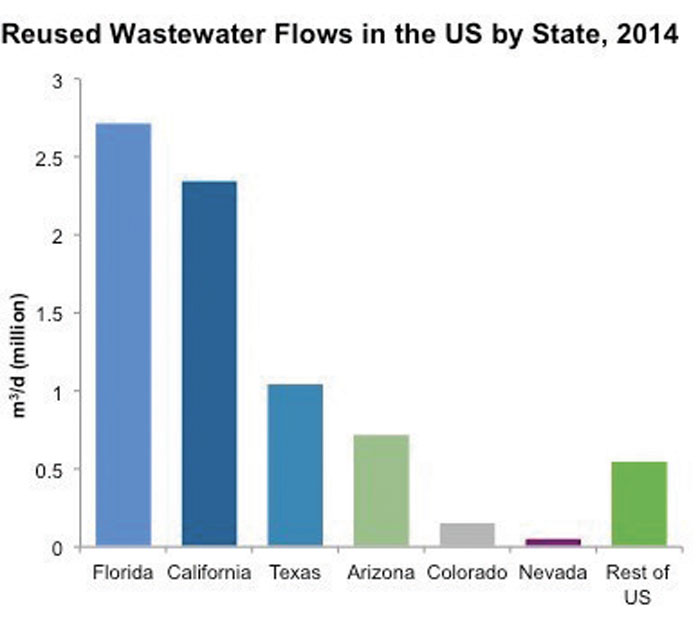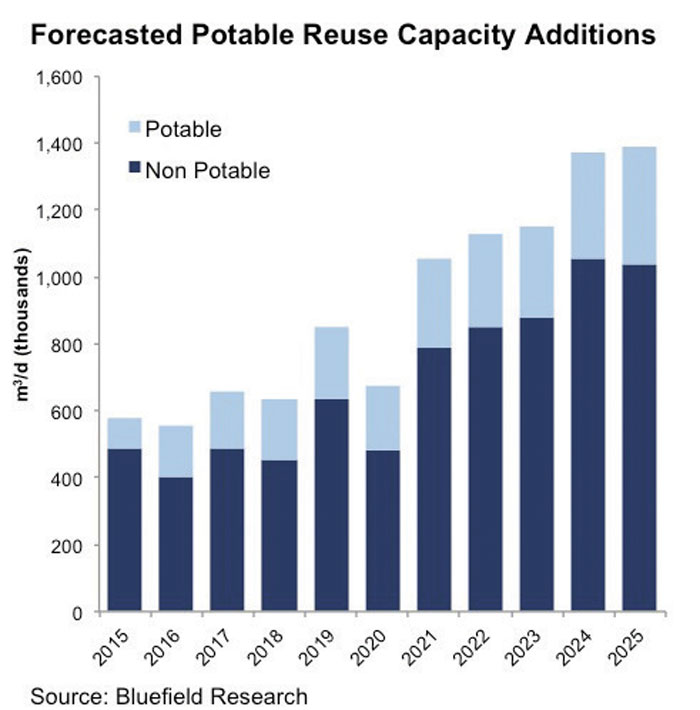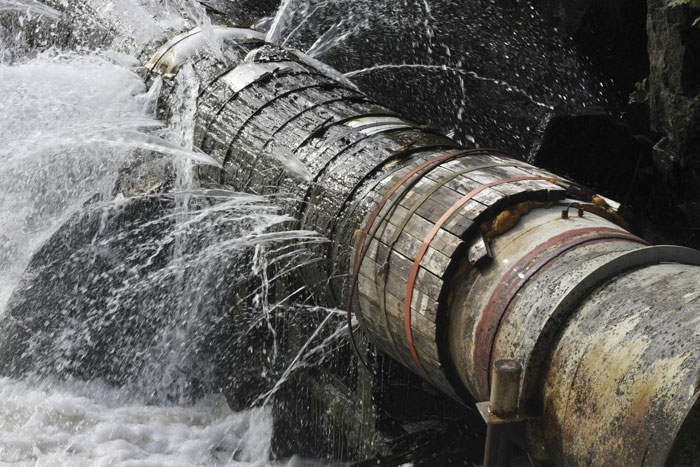As the utilities operations manager for the City of Wichita Falls in north-central Texas, Daniel Nix knows that water is a precious and scarce commodity for the municipality located in an area that averages about 30 inches of rainfall annually. The drought cycle hits the region every 10 to 15 years, and the impact from the latest dry spell was especially tough on the community's water resources.
"All of that came to a head in this most recent drought when we had two years of back-to-back precipitation below 20 inches annually and one year of record-breaking temperatures where we had 100-degree temperatures for 100 days," Nix said. "We typically only have 26 days over 100 degrees" in a year, he added. The severe weather pattern that hit in 2011 and continued the following year—when "it was a little bit better" because "we only had 50 days over 100," Nix said—contributed to ongoing challenges for supplying water in the city that has just north of 100,000 residents. "We realized that if we are going to be a viable municipal area for industry and everything, we need to make our resources more sustainable, so we began in the late '90s looking at reuse options," Nix said. Wichita Falls in July 2014 implemented a direct potable reuse program, which utilized water treated at the local wastewater plant. Instead of releasing the treated liquid back into the environment through reservoirs or rivers, the system returned the treated water back to the city's system for further filtration and treatment using multiple steps, including reverse osmosis and others, to meet strict drinking-water standards. "We realized the wastewater effluent was basically a nonstop source of water we were just throwing into the Big Wichita River," Nix said. "We realized that resource is one we could capture and keep in our resource loop." Wichita Falls is not alone as many communities in the U.S. and around the globe are taking extensive steps to conserve water for their cities to use—and reuse.Saving Water
In the U.S., ongoing drought conditions and other environmental impacts are expected to contribute to a 61 percent increase in wastewater reuse by 2025, according to a report released in July 2015 by Bluefield Research, a firm based in Boston, Massachusetts, that focuses on strategic water analysis. The 61 percent increase is expected to require $11 billion of capital expenditures, with 94 percent of the dollars spent focusing on nine states—mainly Florida and California, the organization stated. "Potable reuse—treating wastewater to drinking water quality—currently makes up 15 percent of the total capacity but is expected to increase to 19 percent of total water reuse by 2025," according to a statement from Bluefield Research about the study. "The expected jump in potable reuse stems largely from heightening pressure on policymakers and utilities to stay ahead of scaling urban populations, anticipated future droughts and limited water supply alternatives." Bluefield Research noted that more than 247 reuse projects are in the works in the U.S. Erin Bonney Casey, a research analyst with Bluefield Research, said that more than $1.9 billion of reuse applications have been submitted for approval just in California. "We're seeing a lot of communities addressing this in response to drought. California has really been pushing for reuse because of the current situation they're in. Texas is also supporting reuse," Bonney Casey said. She pointed to major projects involving water reuse in Texas including the one in Wichita Falls, as well as another program in Big Spring that started a couple years earlier. "Elsewhere in the country, we're definitely seeing an increase in reuse systems," she said, pointing to Texas, Florida and California as the largest areas of activity in the U.S. Around the world, prime examples of countries leading the charge are outside of North America. "The global leaders of reuse systems would be Singapore and Israel," Bonney Casey said. "Singapore historically has imported a lot of its water from Malaysia. That has some international-relations risks to it, so they're looking for a more localized water supply, and being an island, they're looking at it more aggressively."Reuse in Singapore
Singapore is a small but crowded island that spans about 278 square miles (roughly 720 square kilometers) and boasts a population of more than 5.5 million people. "In the '60s and '70s, our country was polluted. We had no sewer, and we faced droughts and floods," Maurice Neo, director of the Industry Development Department for Singapore's PUB, or Public Utilities Board, which oversees the country's water infrastructure, said at the 2015 International Desalination Association World Congress gathering. "Now we collect every drop of used water and rainwater.".jpg) Image 2. Gayland Bragg with the City of Wichita Falls, Texas, performed work in the municipality's reverse-osmosis plant for the direct potable reuse water program. (Courtesy of City of Wichita Falls, Texas)
Image 2. Gayland Bragg with the City of Wichita Falls, Texas, performed work in the municipality's reverse-osmosis plant for the direct potable reuse water program. (Courtesy of City of Wichita Falls, Texas)Toilet to Tap
Part of the challenge with wastewater reuse for potable systems is not just the technology but public buy-in. "A lot of people think of it as toilet water, but really toilet water is only a small portion of the overall sewer usage," said Nix, the utilities operations manager for the City of Wichita Falls. "Toilet facilities are less than 20 percent of that flow," with the vast majority of wastewater coming from showers, sinks, laundry equipment and other household uses, he said.A.jpg) Image 1. Reverse osmosis is a critical part of the direct potable reuse water program that served the City of Wichita Falls, Texas. (Courtesy of City of Wichita Falls, Texas)
Image 1. Reverse osmosis is a critical part of the direct potable reuse water program that served the City of Wichita Falls, Texas. (Courtesy of City of Wichita Falls, Texas)Business Potential
Companies from a variety of industries spanning pump-related businesses, filtration systems and others could benefit from the increase in water reuse projects in the coming years. When asked about observations concerning the importance of water reuse in communities, Dieter Sauer, president of Grundfos Water Utility Inc. based in the Chicago area, said, "It's a topic of conversation that is increasing in frequency every month." Table 2. Florida and California were leaders in the country in the amount of reused wastewater flows in 2014. (Courtesy of Bluefield Research)
Table 2. Florida and California were leaders in the country in the amount of reused wastewater flows in 2014. (Courtesy of Bluefield Research) Table 1. The capacity for potable and non-potable water reuse is expected to more than double in the U.S. by 2025. (Courtesy of Bluefield Research)
Table 1. The capacity for potable and non-potable water reuse is expected to more than double in the U.S. by 2025. (Courtesy of Bluefield Research)Aging infrastructure could cost $300 billion over next two decades
After conducting a national needs assessment, the U.S. Environmental Protection Agency in a 2009 report estimated that nearly $335 billion is required to address deteriorating infrastructure for drinking water utilities over the next two decades.

Image 3. The Big Spring Raw Water Production Plant in Big Spring, Texas, operated by Colorado River Municipal Water District, utilizes reverse-osmosis racks as well as clean-in-place and micro-filters skids, which are seen in the background. (Courtesy of Colorado River Municipal Water District)
"However, it is becoming more difficult for water utilities to finance these investments," the Water Research Foundation, citing the figure in the EPA report, states in a document about infrastructure challenges in the country.
Noting information from the U.S. General Accounting Office (GAO), the Denver-based nonprofit that works to address water needs around the globe said "there is mounting evidence that the integrity of the U.S. drinking and wastewater infrastructure is at risk and needs a concerted effort to improve the management of key assets—pipelines, treatment plants and other facilities—and a significant effort to maintain, rehabilitate and replace these assets."
Based on GAO information from 2004, the Water Research Foundation notes that "one-third of water utilities have deferred maintenance because of insufficient funding, had 20 percent or more of their pipelines nearing the end of their life, and lacked plans for managing their capital assets."
As technology advances to improve water reuse and overall system efficiency, problems are continuing with improving and maintaining the basic infrastructure in many water utilities around the globe.
"I think the aging infrastructure is probably more of a problem," said Erin Bonney Casey, a research analyst with Bluefield Research in Boston, Massachusetts. "Reuse is more exciting to me because it is new projects and a new way of thinking about water systems. … But we haven't done a great job of maintaining the systems that we have, and that is, in my mind, a bigger priority."
Installing new water filtration equipment and other related system infrastructure can benefit communities the facilities serve, but leaking pipes and other potentially failing components may remain in the utility, Bonney Casey said. "All of these new projects, they're still feeding into the existing infrastructure, so you're losing efficiencies. You build a fancy new plant and you're still leaking water when it goes to be transmitted. I don't think it's a particularly effective way to manage the water supply," she said.
The Water Research Foundation identified the problems associated with aging infrastructure as a tremendous concern. The organization is funding projects that work on repair, rehabilitation and replacement; extending the service life of installed water system components; detecting leaks in systems; and ultimately reducing high-risk water main breaks. "WRF has been funding numerous projects to help communities address these issues through the above actions," according to a statement from the organization.
Technology to pinpoint pipe leaks can help to reduce costs of addressing problems with aging infrastructure at water utilities. "There are some companies that sell smart water systems … that are intended to identify leaks more accurately and proactively," Bonney Casey said. "There has been limited adoption of that in the U.S., but companies are definitely pushing that as a means of bringing the water supply system into the 21st century."
Technology that can find leaks without costly construction projects is another way to help utilities. "The other interesting technology development is looking at how to replace and rehabilitate pipes without digging them up—tunneling or pipe-relining technology that doesn't require you to open up the ground," Bonney Casey said. Many repair projects can be "a disruption to streets and traffic and people, so if you can avoid that, the projects become so much more feasible."

 See more of our State of the Industry 2016 coverage.
See more of our State of the Industry 2016 coverage.